Exploring Electrical Concepts: Force, Charges, and Simple Circuits
VerifiedAdded on 2023/06/04
|5
|1362
|427
Homework Assignment
AI Summary
This assignment delves into fundamental concepts of electrical force, electric charges, and simple circuits. It addresses the nature of electrical forces at the macroscopic scale, the interaction between opposite charges, and the relationship between distance and force. The assignment further explores the properties of insulators and conductors, the behavior of charged objects near water, and the measurement of electric current. It covers essential components of simple circuits, resistance calculations, and energy conversion. The assignment also explains electric and magnetic fields, electromagnetic induction, and the role of semiconductors. The document provides detailed answers and explanations, offering a comprehensive understanding of these key physics principles. Desklib provides a platform for students to access similar solved assignments and past papers.
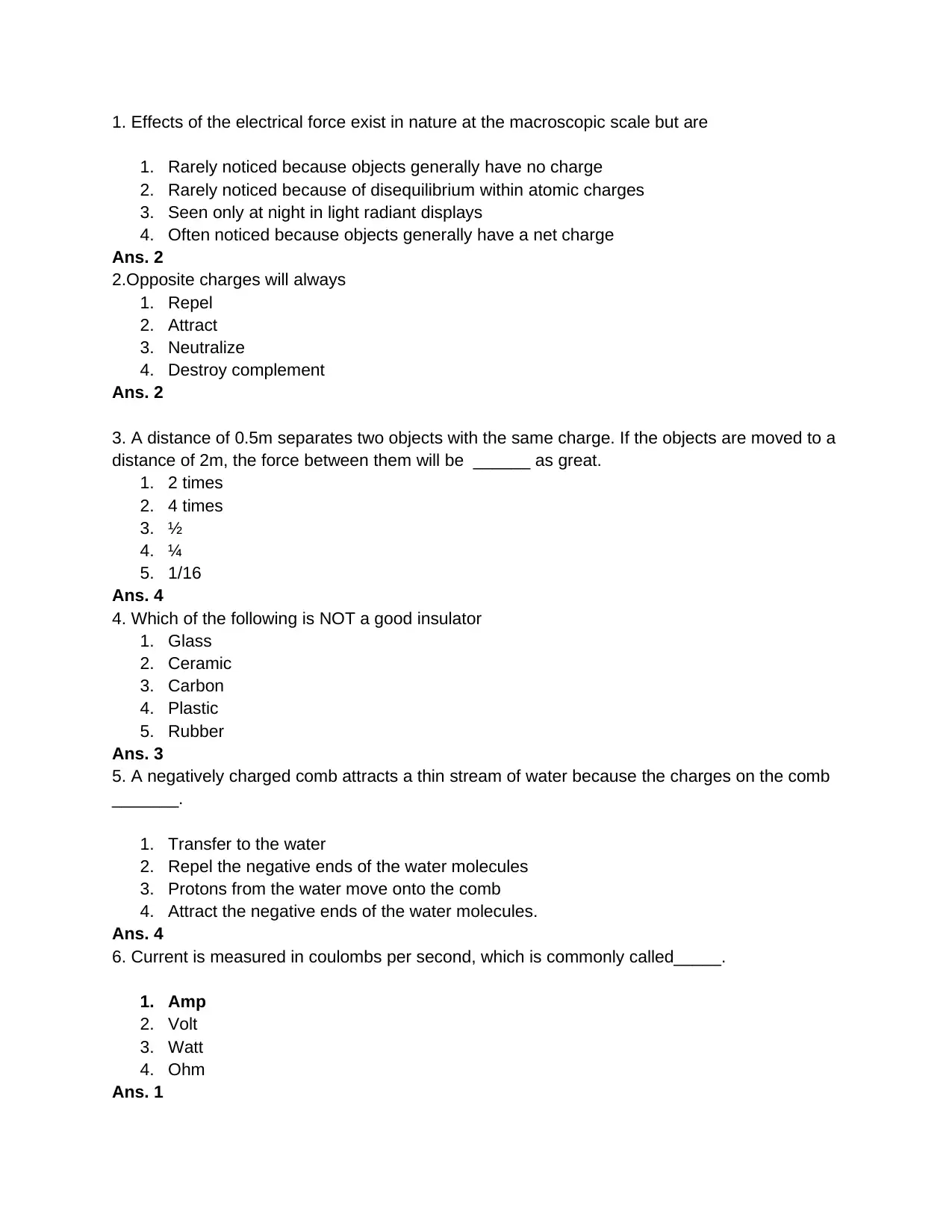
1. Effects of the electrical force exist in nature at the macroscopic scale but are
1. Rarely noticed because objects generally have no charge
2. Rarely noticed because of disequilibrium within atomic charges
3. Seen only at night in light radiant displays
4. Often noticed because objects generally have a net charge
Ans. 2
2.Opposite charges will always
1. Repel
2. Attract
3. Neutralize
4. Destroy complement
Ans. 2
3. A distance of 0.5m separates two objects with the same charge. If the objects are moved to a
distance of 2m, the force between them will be ______ as great.
1. 2 times
2. 4 times
3. ½
4. ¼
5. 1/16
Ans. 4
4. Which of the following is NOT a good insulator
1. Glass
2. Ceramic
3. Carbon
4. Plastic
5. Rubber
Ans. 3
5. A negatively charged comb attracts a thin stream of water because the charges on the comb
_______.
1. Transfer to the water
2. Repel the negative ends of the water molecules
3. Protons from the water move onto the comb
4. Attract the negative ends of the water molecules.
Ans. 4
6. Current is measured in coulombs per second, which is commonly called_____.
1. Amp
2. Volt
3. Watt
4. Ohm
Ans. 1
1. Rarely noticed because objects generally have no charge
2. Rarely noticed because of disequilibrium within atomic charges
3. Seen only at night in light radiant displays
4. Often noticed because objects generally have a net charge
Ans. 2
2.Opposite charges will always
1. Repel
2. Attract
3. Neutralize
4. Destroy complement
Ans. 2
3. A distance of 0.5m separates two objects with the same charge. If the objects are moved to a
distance of 2m, the force between them will be ______ as great.
1. 2 times
2. 4 times
3. ½
4. ¼
5. 1/16
Ans. 4
4. Which of the following is NOT a good insulator
1. Glass
2. Ceramic
3. Carbon
4. Plastic
5. Rubber
Ans. 3
5. A negatively charged comb attracts a thin stream of water because the charges on the comb
_______.
1. Transfer to the water
2. Repel the negative ends of the water molecules
3. Protons from the water move onto the comb
4. Attract the negative ends of the water molecules.
Ans. 4
6. Current is measured in coulombs per second, which is commonly called_____.
1. Amp
2. Volt
3. Watt
4. Ohm
Ans. 1
Paraphrase This Document
Need a fresh take? Get an instant paraphrase of this document with our AI Paraphraser
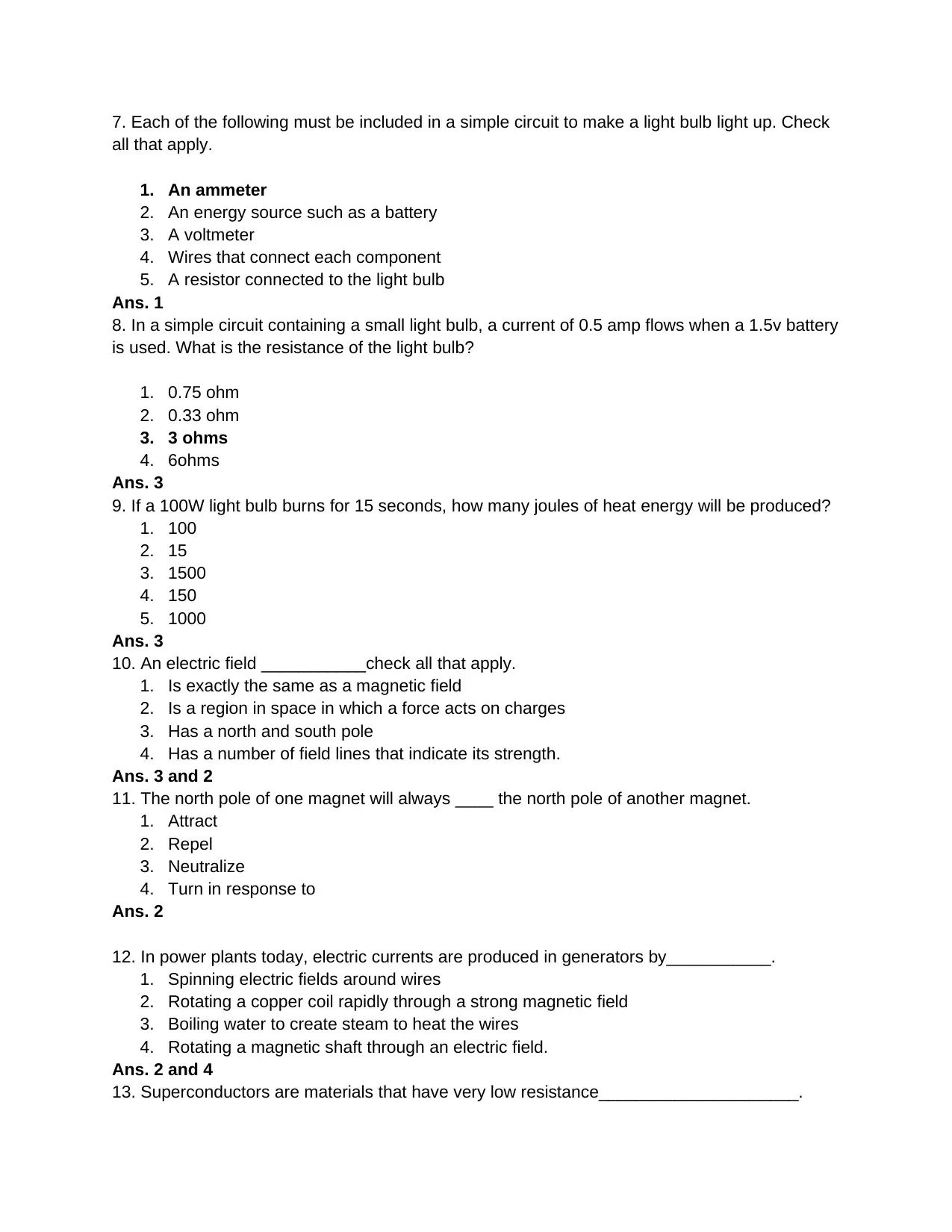
7. Each of the following must be included in a simple circuit to make a light bulb light up. Check
all that apply.
1. An ammeter
2. An energy source such as a battery
3. A voltmeter
4. Wires that connect each component
5. A resistor connected to the light bulb
Ans. 1
8. In a simple circuit containing a small light bulb, a current of 0.5 amp flows when a 1.5v battery
is used. What is the resistance of the light bulb?
1. 0.75 ohm
2. 0.33 ohm
3. 3 ohms
4. 6ohms
Ans. 3
9. If a 100W light bulb burns for 15 seconds, how many joules of heat energy will be produced?
1. 100
2. 15
3. 1500
4. 150
5. 1000
Ans. 3
10. An electric field ___________check all that apply.
1. Is exactly the same as a magnetic field
2. Is a region in space in which a force acts on charges
3. Has a north and south pole
4. Has a number of field lines that indicate its strength.
Ans. 3 and 2
11. The north pole of one magnet will always ____ the north pole of another magnet.
1. Attract
2. Repel
3. Neutralize
4. Turn in response to
Ans. 2
12. In power plants today, electric currents are produced in generators by___________.
1. Spinning electric fields around wires
2. Rotating a copper coil rapidly through a strong magnetic field
3. Boiling water to create steam to heat the wires
4. Rotating a magnetic shaft through an electric field.
Ans. 2 and 4
13. Superconductors are materials that have very low resistance_____________________.
all that apply.
1. An ammeter
2. An energy source such as a battery
3. A voltmeter
4. Wires that connect each component
5. A resistor connected to the light bulb
Ans. 1
8. In a simple circuit containing a small light bulb, a current of 0.5 amp flows when a 1.5v battery
is used. What is the resistance of the light bulb?
1. 0.75 ohm
2. 0.33 ohm
3. 3 ohms
4. 6ohms
Ans. 3
9. If a 100W light bulb burns for 15 seconds, how many joules of heat energy will be produced?
1. 100
2. 15
3. 1500
4. 150
5. 1000
Ans. 3
10. An electric field ___________check all that apply.
1. Is exactly the same as a magnetic field
2. Is a region in space in which a force acts on charges
3. Has a north and south pole
4. Has a number of field lines that indicate its strength.
Ans. 3 and 2
11. The north pole of one magnet will always ____ the north pole of another magnet.
1. Attract
2. Repel
3. Neutralize
4. Turn in response to
Ans. 2
12. In power plants today, electric currents are produced in generators by___________.
1. Spinning electric fields around wires
2. Rotating a copper coil rapidly through a strong magnetic field
3. Boiling water to create steam to heat the wires
4. Rotating a magnetic shaft through an electric field.
Ans. 2 and 4
13. Superconductors are materials that have very low resistance_____________________.
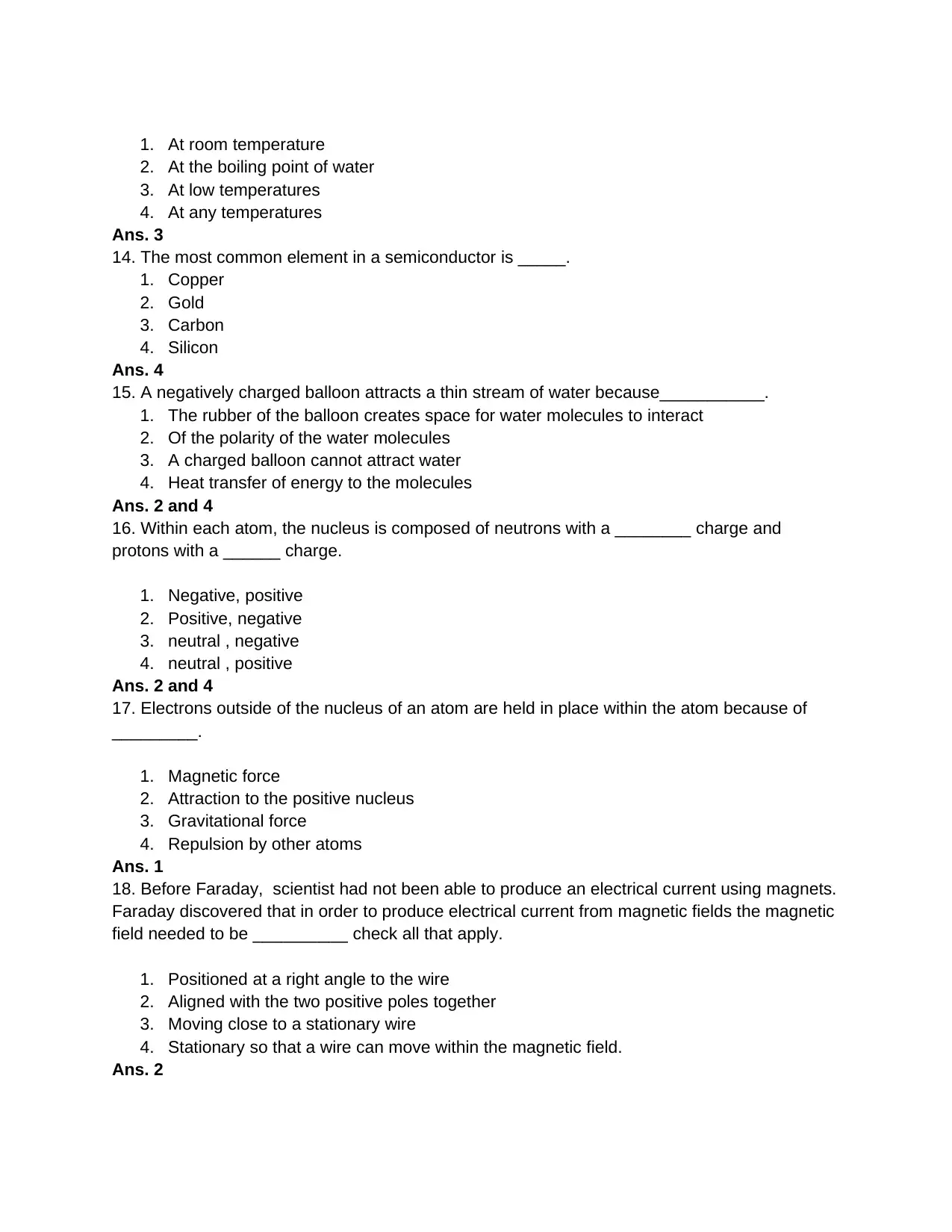
1. At room temperature
2. At the boiling point of water
3. At low temperatures
4. At any temperatures
Ans. 3
14. The most common element in a semiconductor is _____.
1. Copper
2. Gold
3. Carbon
4. Silicon
Ans. 4
15. A negatively charged balloon attracts a thin stream of water because___________.
1. The rubber of the balloon creates space for water molecules to interact
2. Of the polarity of the water molecules
3. A charged balloon cannot attract water
4. Heat transfer of energy to the molecules
Ans. 2 and 4
16. Within each atom, the nucleus is composed of neutrons with a ________ charge and
protons with a ______ charge.
1. Negative, positive
2. Positive, negative
3. neutral , negative
4. neutral , positive
Ans. 2 and 4
17. Electrons outside of the nucleus of an atom are held in place within the atom because of
_________.
1. Magnetic force
2. Attraction to the positive nucleus
3. Gravitational force
4. Repulsion by other atoms
Ans. 1
18. Before Faraday, scientist had not been able to produce an electrical current using magnets.
Faraday discovered that in order to produce electrical current from magnetic fields the magnetic
field needed to be __________ check all that apply.
1. Positioned at a right angle to the wire
2. Aligned with the two positive poles together
3. Moving close to a stationary wire
4. Stationary so that a wire can move within the magnetic field.
Ans. 2
2. At the boiling point of water
3. At low temperatures
4. At any temperatures
Ans. 3
14. The most common element in a semiconductor is _____.
1. Copper
2. Gold
3. Carbon
4. Silicon
Ans. 4
15. A negatively charged balloon attracts a thin stream of water because___________.
1. The rubber of the balloon creates space for water molecules to interact
2. Of the polarity of the water molecules
3. A charged balloon cannot attract water
4. Heat transfer of energy to the molecules
Ans. 2 and 4
16. Within each atom, the nucleus is composed of neutrons with a ________ charge and
protons with a ______ charge.
1. Negative, positive
2. Positive, negative
3. neutral , negative
4. neutral , positive
Ans. 2 and 4
17. Electrons outside of the nucleus of an atom are held in place within the atom because of
_________.
1. Magnetic force
2. Attraction to the positive nucleus
3. Gravitational force
4. Repulsion by other atoms
Ans. 1
18. Before Faraday, scientist had not been able to produce an electrical current using magnets.
Faraday discovered that in order to produce electrical current from magnetic fields the magnetic
field needed to be __________ check all that apply.
1. Positioned at a right angle to the wire
2. Aligned with the two positive poles together
3. Moving close to a stationary wire
4. Stationary so that a wire can move within the magnetic field.
Ans. 2
⊘ This is a preview!⊘
Do you want full access?
Subscribe today to unlock all pages.

Trusted by 1+ million students worldwide
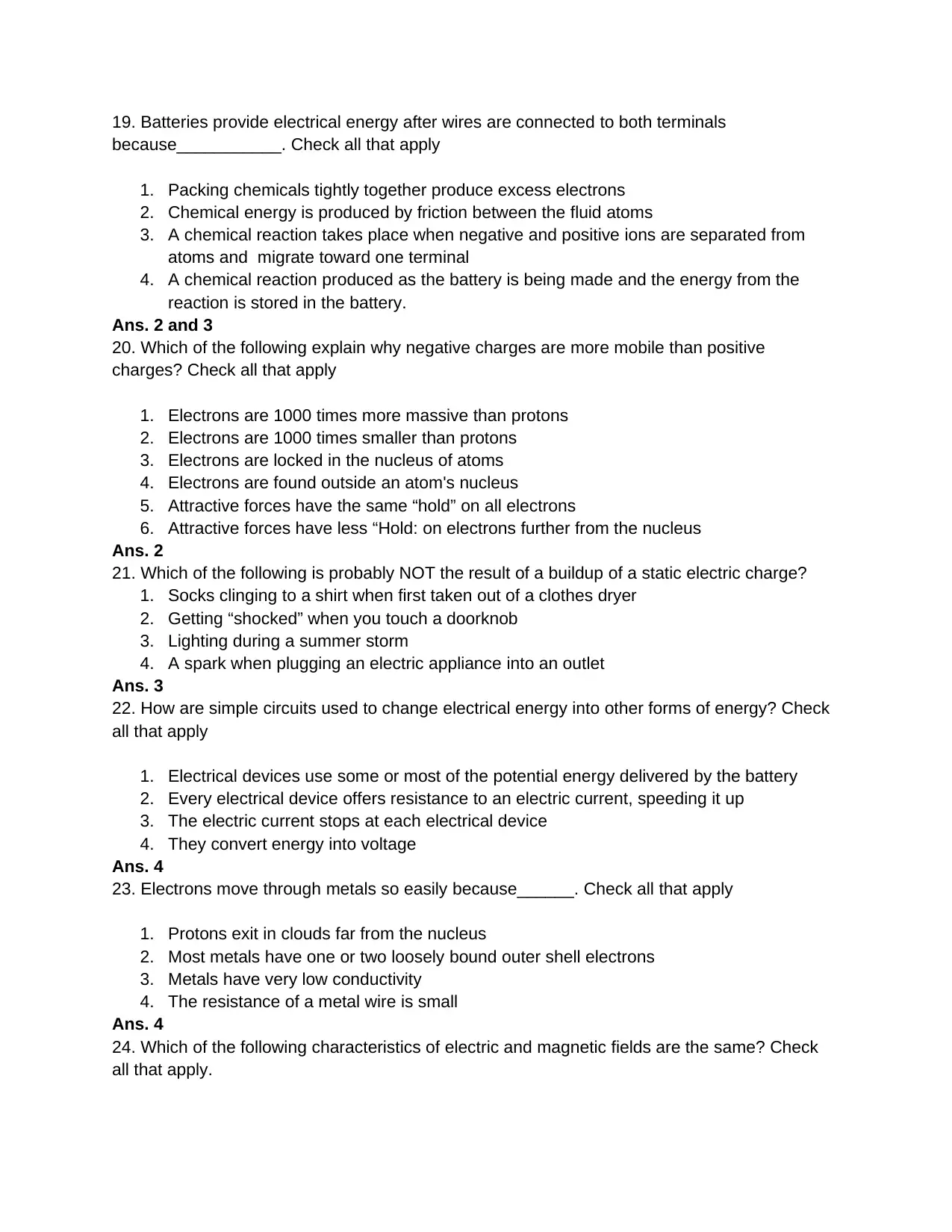
19. Batteries provide electrical energy after wires are connected to both terminals
because___________. Check all that apply
1. Packing chemicals tightly together produce excess electrons
2. Chemical energy is produced by friction between the fluid atoms
3. A chemical reaction takes place when negative and positive ions are separated from
atoms and migrate toward one terminal
4. A chemical reaction produced as the battery is being made and the energy from the
reaction is stored in the battery.
Ans. 2 and 3
20. Which of the following explain why negative charges are more mobile than positive
charges? Check all that apply
1. Electrons are 1000 times more massive than protons
2. Electrons are 1000 times smaller than protons
3. Electrons are locked in the nucleus of atoms
4. Electrons are found outside an atom's nucleus
5. Attractive forces have the same “hold” on all electrons
6. Attractive forces have less “Hold: on electrons further from the nucleus
Ans. 2
21. Which of the following is probably NOT the result of a buildup of a static electric charge?
1. Socks clinging to a shirt when first taken out of a clothes dryer
2. Getting “shocked” when you touch a doorknob
3. Lighting during a summer storm
4. A spark when plugging an electric appliance into an outlet
Ans. 3
22. How are simple circuits used to change electrical energy into other forms of energy? Check
all that apply
1. Electrical devices use some or most of the potential energy delivered by the battery
2. Every electrical device offers resistance to an electric current, speeding it up
3. The electric current stops at each electrical device
4. They convert energy into voltage
Ans. 4
23. Electrons move through metals so easily because______. Check all that apply
1. Protons exit in clouds far from the nucleus
2. Most metals have one or two loosely bound outer shell electrons
3. Metals have very low conductivity
4. The resistance of a metal wire is small
Ans. 4
24. Which of the following characteristics of electric and magnetic fields are the same? Check
all that apply.
because___________. Check all that apply
1. Packing chemicals tightly together produce excess electrons
2. Chemical energy is produced by friction between the fluid atoms
3. A chemical reaction takes place when negative and positive ions are separated from
atoms and migrate toward one terminal
4. A chemical reaction produced as the battery is being made and the energy from the
reaction is stored in the battery.
Ans. 2 and 3
20. Which of the following explain why negative charges are more mobile than positive
charges? Check all that apply
1. Electrons are 1000 times more massive than protons
2. Electrons are 1000 times smaller than protons
3. Electrons are locked in the nucleus of atoms
4. Electrons are found outside an atom's nucleus
5. Attractive forces have the same “hold” on all electrons
6. Attractive forces have less “Hold: on electrons further from the nucleus
Ans. 2
21. Which of the following is probably NOT the result of a buildup of a static electric charge?
1. Socks clinging to a shirt when first taken out of a clothes dryer
2. Getting “shocked” when you touch a doorknob
3. Lighting during a summer storm
4. A spark when plugging an electric appliance into an outlet
Ans. 3
22. How are simple circuits used to change electrical energy into other forms of energy? Check
all that apply
1. Electrical devices use some or most of the potential energy delivered by the battery
2. Every electrical device offers resistance to an electric current, speeding it up
3. The electric current stops at each electrical device
4. They convert energy into voltage
Ans. 4
23. Electrons move through metals so easily because______. Check all that apply
1. Protons exit in clouds far from the nucleus
2. Most metals have one or two loosely bound outer shell electrons
3. Metals have very low conductivity
4. The resistance of a metal wire is small
Ans. 4
24. Which of the following characteristics of electric and magnetic fields are the same? Check
all that apply.
Paraphrase This Document
Need a fresh take? Get an instant paraphrase of this document with our AI Paraphraser
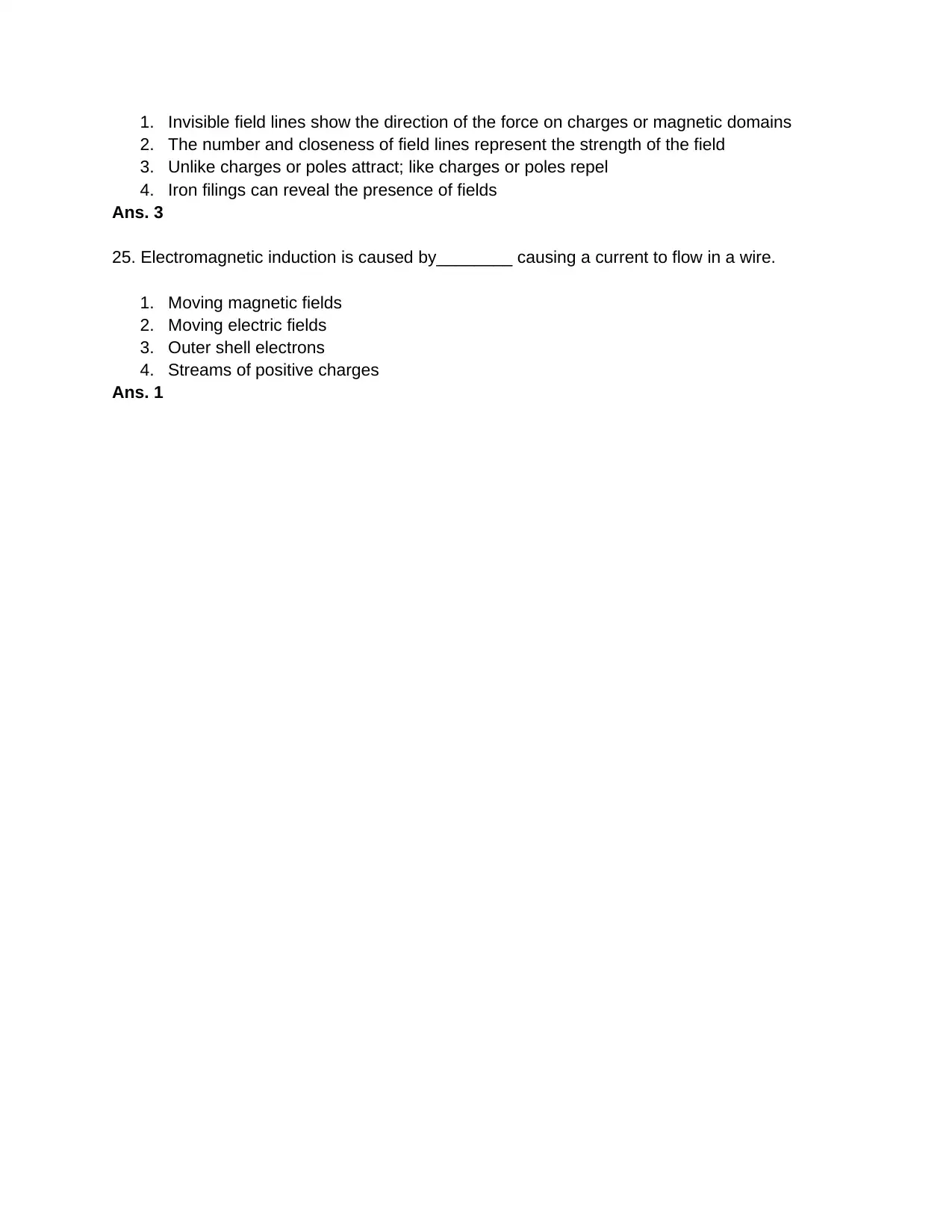
1. Invisible field lines show the direction of the force on charges or magnetic domains
2. The number and closeness of field lines represent the strength of the field
3. Unlike charges or poles attract; like charges or poles repel
4. Iron filings can reveal the presence of fields
Ans. 3
25. Electromagnetic induction is caused by________ causing a current to flow in a wire.
1. Moving magnetic fields
2. Moving electric fields
3. Outer shell electrons
4. Streams of positive charges
Ans. 1
2. The number and closeness of field lines represent the strength of the field
3. Unlike charges or poles attract; like charges or poles repel
4. Iron filings can reveal the presence of fields
Ans. 3
25. Electromagnetic induction is caused by________ causing a current to flow in a wire.
1. Moving magnetic fields
2. Moving electric fields
3. Outer shell electrons
4. Streams of positive charges
Ans. 1
1 out of 5
Your All-in-One AI-Powered Toolkit for Academic Success.
+13062052269
info@desklib.com
Available 24*7 on WhatsApp / Email
![[object Object]](/_next/static/media/star-bottom.7253800d.svg)
Unlock your academic potential
Copyright © 2020–2025 A2Z Services. All Rights Reserved. Developed and managed by ZUCOL.

